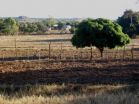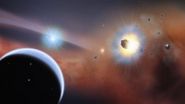(Press-News.org) NASA's Hubble Space Telescope has recorded the never-before-seen break-up of an asteroid into as many as 10 smaller pieces.
Fragile comets, comprised of ice and dust, have been seen falling apart as they near the sun, but nothing like this has ever before been observed in the asteroid belt.
"This is a rock, and seeing it fall apart before our eyes is pretty amazing," said David Jewitt of the University of California at Los Angeles, who led the astronomical forensics investigation.
The crumbling asteroid, designated P/2013 R3, was first noticed as an unusual, fuzzy-looking object by the Catalina and Pan STARRS sky surveys on Sept. 15, 2013. A follow-up observation on October 1 with the W. M. Keck Observatory on the summit of Mauna Kea, a dormant volcano on the island of Hawaii, revealed three bodies moving together in an envelope of dust nearly the diameter of Earth.
"The Keck Observatory showed us this thing was worth looking at with Hubble," Jewitt said. "With its superior resolution, space telescope observations soon showed there were really 10 embedded objects, each with comet-like dust tails. The four largest rocky fragments are up to 400 yards in diameter, about four times the length of a football field."
Hubble data showed the fragments drifting away from each other at a leisurely one mph. The asteroid began coming apart early last year, but new pieces continue to reveal themselves, as proved in the most recent images.
It is unlikely the asteroid is disintegrating because of a collision with another asteroid, which would have been instantaneous and violent by comparison to what has been observed. Debris from such a high-velocity smashup would also be expected to travel much faster than observed. Nor is the asteroid coming unglued due to the pressure of interior ices warming and vaporizing.
This leaves a scenario in which the asteroid is disintegrating due to a subtle effect of sunlight, which causes the rotation rate of the asteroid to gradually increase. Eventually, its component pieces -- like grapes on a stem -- succumb to centrifugal force and gently pull apart. The possibility of disruption in this manner has been discussed by scientists for several years, but never reliably observed.
For this scenario to occur, P/2013 R3 must have a weak, fractured interior -- probably as the result of numerous non-destructive collisions with other asteroids. Most small asteroids are thought to have been severely damaged in this way. P/2013 R3 is likely the byproduct of just such a collision sometime in the last billion years.
With the previous discovery of an active asteroid spouting six tails, named P/2013 P5, astronomers are finding more evidence the pressure of sunlight may be the primary force causing the disintegration of small asteroids -- less than a mile across-- in our solar system.
The asteroid's remnant debris, weighing about 200,000 tons, will in the future provide a rich source of meteoroids. Most will eventually plunge into the sun, but a small fraction of the debris may one day blaze across our skies as meteors.
INFORMATION:
The Hubble Space Telescope is a project of international cooperation between NASA and the European Space Agency. NASA's Goddard Space Flight Center in Greenbelt, Md., manages the telescope. The Space Telescope Science Institute (STScI) in Baltimore conducts Hubble science operations. STScI is operated for NASA by the Association of Universities for Research in Astronomy, Inc., in Washington.
For images and more information about Hubble, visit:
http://www.nasa.gov/hubble
NASA's Hubble Telescope witnesses asteroid's mysterious disintegration
2014-03-06
ELSE PRESS RELEASES FROM THIS DATE:
Nearby star's icy debris suggests 'shepherd' planet
2014-03-06
VIDEO:
NASA Goddard's Aki Roberge explains how observations with the Atacama Large Millimeter/submillimeter Array in Chile tell us about poison gas, comet swarms and a hypothetical planet around Beta Pictoris....
Click here for more information.
An international team of astronomers exploring the disk of gas and dust around a nearby star have uncovered a compact cloud of poisonous gas formed by ongoing rapid-fire collisions among a swarm of icy, comet-like bodies. The researchers ...
Study provides new information about the sea turtle 'lost years'
2014-03-06
MIAMI – A new study satellite tracked 17 young loggerhead turtles in the Atlantic Ocean to better understand sea turtle nursery grounds and early habitat use during the 'lost years.' The study, conducted by a collaborative research team, including scientists from the University of Miami (UM) Rosenstiel School of Marine and Atmospheric Science, was the first long-term satellite tracking study of young turtles at sea.
"This is the first time we were able to show the maiden voyage of young turtles after they left the beach," said Rosenstiel School scientist Jiangang Luo ...
$4M grant to improve asthma care for So Cal Latino youth
2014-03-06
SAN DIEGO, Calif. (March 6, 2014)—A team led by researchers at San Diego State University has been awarded $4 million to enhance asthma education and treatment strategies in California's Imperial Valley, where children are twice as likely as the national average to suffer from asthma.
The grant will allow researchers to better understand the specific asthma needs of Imperial Valley's largely Latino/Latina population, as well as develop more effective approaches to treatment for families, communities, and physicians.
Approximately 4.5 million African-Americans and 3.6 ...
Fertilizer in small doses yields higher returns for less money
2014-03-06
URBANA, Ill. - Crop yields in the fragile semi-arid areas of Zimbabwe have been declining over time due to a decline in soil fertility resulting from mono-cropping, lack of fertilizer, and other factors. In collaboration with the International Crops Research Institute for the Semi-Arid Tropics (ICRISAT), University of Illinois researchers evaluated the use of a precision farming technique called "microdosing," its effect on food security, and its ability to improve yield at a low cost to farmers.
"Microdosing involves applying a small, affordable amount of fertilizer ...
Story Tips from the Department of Energy's Oak Ridge National Laboratory, March 2014
2014-03-06
MATERIALS – Lighter, stronger engines . . .
Engines could become lighter and more efficient because of a research project that combines the talents and resources of the Chrysler Group, Nemak S.A. of Mexico and Oak Ridge National Laboratory. The goal of the four-year $5.5 million cooperative research and development agreement is to develop an advanced cast aluminum alloy for next-generation higher efficiency engines. In addition to being lighter, the new alloy for cylinder heads would be stronger and capable of sustaining the higher temperatures and pressures of engines ...
Preschoolers can outsmart college students at figuring out gizmos
2014-03-06
Preschoolers can be smarter than college students at figuring out how unusual toys and gadgets work because they're more flexible and less biased than adults in their ideas about cause and effect, according to new research from the University of California, Berkeley, and the University of Edinburgh.
The findings suggest that technology and innovation can benefit from the exploratory learning and probabilistic reasoning skills that come naturally to young children, many of whom are learning to use smartphones even before they can tie their shoelaces. The findings also ...
Kawasaki disease and pregnant women
2014-03-06
In the first study of its type, researchers at the University of California, San Diego School of Medicine have looked at the health threat to pregnant women with a history of Kawasaki disease (KD), concluding that the risks are low with informed management and care.
The findings are published in the March 6, 2014 online edition of the British Journal of Obstetrics and Gynaecology.
KD is a childhood condition affecting the coronary arteries. It is the most common cause of acquired heart disease in children. First recognized in Japan following World War II, KD diagnoses ...
Early detection helps manage a chronic graft-vs.-host disease complication
2014-03-06
SEATTLE – A simple questionnaire that rates breathing difficulties on a scale of 0 to 3 predicts survival in chronic graft-vs.-host disease, according to a study published in the March issue of Biology of Blood and Marrow Transplantation.
And although a poor score means a higher risk of death, asking a simple question that can spot lung involvement early means that patients can begin treatments to reduce or manage symptoms, said senior author Stephanie Lee, M.D., M.P.H., research director of Fred Hutchinson Cancer Research Center's Long-Term Follow-Up Program, member ...
Crashing comets explain surprise gas clump around young star
2014-03-06
Beta Pictoris, a nearby star easily visible to the naked eye in the southern sky, is already hailed as the archetypal young planetary system. It is known to harbour a planet that orbits some 1.2 billion kilometres from the star, and it was one of the first stars found to be surrounded by a large disc of dusty debris [1].
New observations from ALMA now show that the disc is permeated by carbon monoxide gas.
Paradoxically the presence of carbon monoxide, which is so harmful to humans on Earth, could indicate that the Beta Pictoris planetary system may eventually become ...
ALMA sees icy wreckage in nearby solar system
2014-03-06
Astronomers using the Atacama Large Millimeter/submillimeter Array (ALMA) telescope have discovered the splattered remains of comets colliding together around a nearby star; the researchers believe they are witnessing the total destruction of one of these icy bodies once every five minutes.
The "smoking gun" implicating this frosty demolition is the detection of a surprisingly compact region of carbon monoxide (CO) gas swirling around the young, nearby star Beta Pictoris.
"Molecules of CO can survive around a star for only a brief time, about 100 years, before being ...






